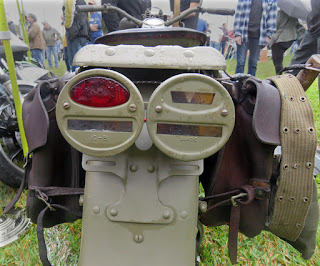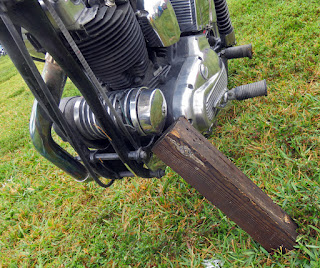 |
| Would a dispatch rider of World War II have carried all of this gear? |
The
2019 Dania Beach Vintage Motorcycle Show was a delight for the imagination.
What, you ask, could be creative about old motorcycles that have been restored, presumably, to original, identical, mass-produced condition? Well...
The 1944 Harley-Davidson WLA military motorcycle shown by Bob Benyo of North Miami, Fla. at the Globe Motorcycles Ltd. booth probably deserves an award for most accessories.
Including a bomb.
But let's go on from there to add a Tommy Gun, ammunition bag, .45 automatic, entrenching tool, canteen, machete, separate black-out lights and so on.
 |
| Can you imagine riding below 10 degrees Fahrenheit? There was a war on, buddy. |
"Do not exceed 65 mph" the tag on the tank warns the GI rider. Surely that was hella fast on the 45-cubic-inch sidevalve V-twin. Compression ratio on an Army WLA was a sparkling 5:1.
Although obviously a heavyweight motorcycle, the fenders on a WLA appear surprisingly svelte. The Army wanted the fender sides cut away to avoid clogging with mud. Ick.
 |
| Extra set of lights for black-out riding were standard equipment. |
Least you think Harley WLAs were obsolete — even in 1944 — WLA production was actually revived for the Korean War. That's how valuable they were.
I don't tend to take a lot of photos of Harley-Davidsons, but the "kick stand" on a 1968 Sportster caught my eye. Described as an old-school barn find with "original tires" (tread flaking off) it was for sale.
 |
| Don't laugh: it worked. The factory stand didn't. |
The seller decried the standard kick stand on these bikes, as even with reinforcement his had collapsed that very morning. If I was the buyer I would insist on getting the wooden substitute, which appeared to be doing a fine job of holding up the bike. What could be more old school than lumber?
Another example of make-do technology was apparent on the 1945 Simplex Servi-Cycle shown by John Schultz of Fort Worth, Texas. Despite the obvious lack of half its gas tank, this motorcycle was shown running!
 |
| Looks like a little rust-out in the tank. But it ran! |
It could not have been much more capable brand new. Note the whimsical springs for front suspension. But it has a stout handle for the brake, full floor boards, electric horn and lighting and a kick stand. The sprung seat is an engineering wonder, with one spring! Look at the female figure on the license plate holder, thumbing her nose.
 |
| 1973 Rickman Metisse with Kawasaki power. |
Looking to be in a whole lot better condition was the 1973 Rickman Metisse 900 CR, with Kawasaki KZ900 engine, shown by Globe Motorcycles Ltd. Rickman stopped producing complete motorcycles in 1975. This must have been one of its most formidable.
 |
| Pure class. Rickman was known for its fine fiberglass work. |
 |
| Nothing like four pipes to make a bike look formidable. |
 |
Velocette LE 200 was cute, maybe, but not beautiful.
Compare it to the Matchless parked just behind it. |
Another unusual motorcycle was the 1960 Velocette LE 200 shown by Mark Sepulveda of Hialeah, Fla. I almost said "attractive and unusual," but the LE 200 wasn't meant to be pretty.
It was was a real departure for Velocette, one of those mid-century attempts to make a motorcycle as convenient as a scooter, with good weather protection for the legs, floor boards for the feet and a glove box of sorts. Motor, gearbox, drive shaft and final drive were one package, eliminating the chain. The motor was a four-stroke, water-cooled horizontally-opposed twin.
 |
| LE 200 mimicked a scooter. |
"LE 200" meant "Little Engine, 200cc." It didn't make much noise and bodywork was insulated so riders claimed you couldn't hear the motor running.
Despite its boxy looks, the LE 200 has a finely sculptured lighting nacelle containing the instruments. Too bad the rest of the design deliberately shrugged off any concern for beauty. They stayed in production from 1948 until Velocette came to an end in 1970.
 |
| Lovely sculpted nacelle on boxy motorcycle. |
 |
LE 200 had a radiator for water cooling.
Leg guard provided mounting for an air pump. |
See my previous blog item for
more great motorcycles from the 2019 Dania Beach Vintage Motorcycle Show.




































No comments:
Post a Comment